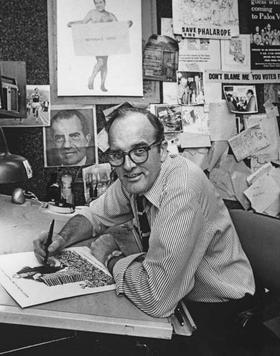Paul Conrad (Paul Conrad)

Political Cartoonist. A controversial legend in his field, he saw himself as a defender of the common man and savagely skewered those in power for nearly 60 years, to the delight or outrage of his readers. He is probably best remembered for his takes on the Vietnam War, the Watergate scandal, and the Reagan era. Conrad worked for the Denver Post from 1950 to 1964 and was chief editorial cartoonist for the Los Angeles Times from 1964 to 1993, while his work was syndicated in hundreds of newspapers worldwide. In the process he won three Pulitzer Prizes, in 1964, 1971, and 1984. President Gerald Ford once lamented, “Laugh and the world laughs with you. Cry and you’ve been the subject of a Paul Conrad cartoon”. Paul Francis Conrad was born in Cedar Rapids, Iowa. During World War II he served in the Pacific with the Army Corps of Engineers and saw action in the invasions of Guam and Okinawa. Following his service he enrolled at the University of Iowa, where his drawings for the college newspaper brought him his first job at the Denver Post. Known as a pugnacious man with committed opinions (“No one’s ever accused me of being objective”), he quickly developed a take-no-prisoners style: sparse images boldly drawn, with little or no text. He had a strong sense of history and sometimes drew inspiration from 19th Century cartoonists such as Honoré Daumier, Thomas Nast, and Bernard Gillam. Conrad first came to national prominence with his observations of the Civil Rights movement, which culminated with his first Pulitzer win and a move to the Los Angeles Times. As a lifelong liberal Democrat he relished baiting Republicans and found his most enduring targets in Richard Nixon and Ronald Reagan. President Nixon put Conrad on his “enemies list” in 1973, which the cartoonist considered his proudest achievement, and had his opponent’s taxes audited four times. But he readily took on any Democrat who came into his crosshairs, from Harry Truman and Ted Kennedy to Jimmy Carter and Bill Clinton. “I decide who’s right or wrong, and go from there”, he stated flatly. Over his career he was unsuccessfully sued for libel by Los Angeles Mayor Sam Yorty and Union 76 president Fred Hartley, and denounced in angry open letters from such figures as Cardinal Timothy Manning and Frank Sinatra. Changes in management at the Times prompted him to accept a buyout in 1993, though he continued to draw for Tribune Media Services. During the late 1980s Conrad began creating bronze sculptures on political subjects, much as Daumier had done. Many have been exhibited at the Los Angeles County Museum of Art. They include “Billary”, a Janus-head portrayal of Bill and Hillary Clinton, and a “portrait” of George W. Bush consisting of a ten-gallon hat, a pair of cowboy boots, and nothing in between. Most imposing is the 26 foot-tall “Chain Reaction” (1991), which now stands outside the Santa Monica Civic Center in Santa Monica, California. He also published several collections of his cartoons, wrote a memoir, “I, Con: The Autobiography of Paul Conrad, Editioral Cartoonist” (2006), and was the subject of the PBS documentary “Paul Conrad: Drawing Fire” (2006). Vowing never to retire, Conrad produced four cartoons a week for syndication until shortly before his death at 86. (bio by: Bobb Edwards)
Born
- June, 27, 1924
- USA
Died
- September, 09, 2010
- USA
Cemetery
- Green Hills Memorial Park
- California
- USA

